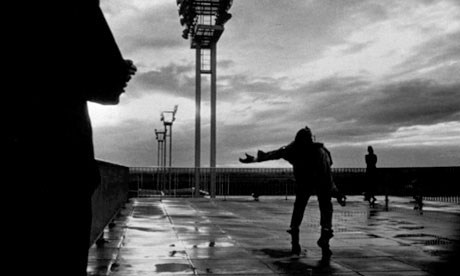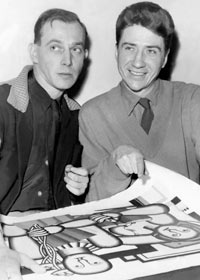Chris Marker obituary
Experimental French director acclaimed for his post-apocalyptic film La Jetée
E

Chris Marker's La Jetée was semi-remade by Terry Gilliam as 12 Monkeys
The essay film, a form pitched between documentary and personal reflection, exploring the subjectivity of the cinematic perspective, has now become an accepted genre. Jean-Marie Straub, Danièle Huillet,Jean-Luc Godard, Errol Morris and Michael Moore are among its main recent exponents, but Chris Marker, who has died aged 91, was credited with inventing the form.
Marker's creative use of sound, images and text in his poetic, political and philosophical documentaries made him one of the most inventive of film-makers. They looked forward to what is called "the new documentary", but also looked back to the literary essay in the tradition of Michel de Montaigne. Marker's interests lay in transitional societies – "life in the process of becoming history," as he put it. How do various cultures perceive and sustain themselves and each other in the increasingly intermingled modern world?
He was born Christian François Bouche-Villeneuve, most likely in Neuilly-sur-Seine, on the outskirts of Paris, although one source gives the place of birth as Ulan Bator, the capital of Mongolia – a legend that Marker did nothing to dispel. His pseudonym is said to have been taken from the Magic Marker pen.
 Chris Marker, left, with Alain Resnais. The pair collaborated on the propaganda film Far from Vietnam. Photograph: Getty Images/Gamma-Keystone
Chris Marker, left, with Alain Resnais. The pair collaborated on the propaganda film Far from Vietnam. Photograph: Getty Images/Gamma-Keystone
Marker fought in the French Resistance and supposedly with the American armed forces during the second world war. He emerged from the Parisian Left Bank intellectual climate, coming under the influence of two postwar figures, André Malraux and André Bazin, working with the latter on the theatre section of the magazine Travail et Culture, then under the aegis of the French Communist party.
He wrote a novel, Le Coeur Net, published in 1950 and translated the following year as The Forthright Spirit; a book of criticism on the playwright and novelist Jean Giraudoux; poems and short stories; and film reviews for Cahiers du Cinéma. But it was his lucid and committed leftwing documentaries, all of which he wrote and many of which he photographed, made from 1955 to 1966, that established him as a major film-maker. It was during this period that the poet Henri Michaux proclaimed: "The Sorbonne should be razed and Chris Marker put up in its place."
"I write to you from a far-off country," begins Marker's Lettre de Sibérie (Letter from Siberia, 1958), which uses cartoons, texts and voiceover. In the film, Marker questions the objectivity of documentaries by repeating one sequence three times, each with a different commentary. Depending on the commentary, Soviet workers building a road were either "unhappy", "happy" or "noble".
The passionate and influential Cuba Si! (1961) contains two interviews with Fidel Castro. It ends with the Bay of Pigs fiasco, which took place in April 1961, during the editing of the film, which had been shot a few months previously. The anti-American tone of the ending caused the French government to ban the film until 1963, but Marker published the text and stills before then. However, this could not amply communicate the expert use of sound, image and text that makes his films so special.
Marker brought the same foreigner's eye view to bear on his own city in Le Joli Mai (1963), which he compiled from 55 hours of interviews with the people of Paris (boiled down to around two and a half hours) with a linking commentary spoken by Yves Montand (replaced by Simone Signoret in the English version). The interviews assume the form of a dialectic during which Marker's tone is often ironic and judgmental. For example, when one interviewee says he wants material success, Marker remarks that his view of life is "a trifle limited".
Marker's La Jetée (The Pier, 1962), a roughly 30-minute post-third world war story, is made up entirely of stills, except for one brief moving shot of a woman opening her eyes. This futuristic photo-novel film, semi-remade by Terry Gilliam as 12 Monkeys in 1995, abstracts cinema almost to its essence in bringing to life the story of a post-apocalyptic man obsessed with an image from his past.
Set against the backdrop of the 1964 Tokyo Olympics, Le Mystère Koumiko (The Koumiko Mystery, 1965) consists of a series of conversations with an attractive, French-speaking Tokyo resident named Koumiko Muraoka. Through her, and modern Tokyo, Marker is able to comment on the loss of identity in the face of globalism. Koumiko considers her own features too Japanese, while the director interprets the aesthetics of contemporary Japanese fashion as a subconscious desire to neutralise Asiatic features and erase the otherness that attracts Marker himself to the culture (and to the heroine).
In 1966, Marker set up a company, Société pour le Lancement des Oeuvres Nouvelles, to produce new work. It financed Loin du Vietnam (Far from Vietnam, 1967), a timely propaganda piece with contributions directed by Godard, Agnès Varda, Alain Resnais, Joris Ivens and Marker himself.
Le Train en Marche (The Train Rolls On, 1971) was a documentary focusing on the director Alexander Ivanovich Medvedkin, and his CineTrain of the 1930s, on which film crews travelled through the Soviet Union making documentaries. Using archive footage and photographs, Marker illustrates how the CineTrain functioned as the means by which films could include and educate the masses in Russia at the start of the revolution. More than 20 years later, after the fall of Soviet communism, Marker returned to Medvedkin in Le Tombeau d'Alexandre (The Last Bolshevik, 1992). The film is a series of video letters to Medvedkin (who died in 1989) and provides a broader, incisive meditation on the nature of reality, fiction, art, ideology and history.
Taking an even wider perspective was his 1977 film Le Fond de l'Air est Rouge (a slogan from the May 1968 protests). It was given the English title The Grin Without a Cat. Divided into two 90-minute parts, it tells the story of the New Left activist movement, from its birth as a byproduct of the Vietnam war to the CIA's ousting of Salvador Allende in Chile in 1973, which sounded the death knell for ideological hope. For Marker, truth is always a matter of an individual's point of view: history does not exist apart from through our personal experience and interpretation of it.
"You never know what you're filming until later," remarks one of the film's many narrators, summing up Marker's distinctive way of working both within the moment and out of it. In Sans Soleil (Sunless, 1983), a fictional cameraman (a Marker surrogate) tries to make sense of the cultural dislocation he feels in Japan, West Africa and Iceland. Using diverse images, letters, quotes and musings, Marker continued to extend the limits of the documentary, making use of new video technology and image-processing by Hayao Yamaneko, credited with special effects. The result is a film that Marker described as like "a musical composition, with recurrent themes, counterpoints and mirror-like fugues".
"I remember that month of January in Tokyo, or rather, I remember the images I filmed of the month of January in Tokyo," says the narrator. "They have substituted themselves for my memory. They are my memory … the act of remembering is not the opposite of forgetting."
Apart from the Medvedkin documentaries, Marker made further films on directors. AK (1985), profiling the location shooting of Akira Kurosawa's Ran on the slopes of Mount Fuji, included an interview with its 75-year-old director. This reverential impression of the Japanese master at work is revealing about Kurosawa's methods and his relations with his crew. Marker also uses the subject for his own brand of poetic-philosophical celluloid essay on the Japanese and on the making of a film. For the French TV programme Cinéastes de Notre Temps, Marker paid homage to Andrei Tarkovsky in Une Journée d'Andrei Arsenevitch (One Day in the Life of Andrei Arsenevich, 2000).
In the 1990s, Marker expanded into multimedia installation work such as Zapping Zone for the Pompidou Centre. In the film Level Five (1997), he made use of the new video technology and paid homage to Resnais' films on memory and the unconscious. Gradually, a woman called Laura (named after the eponymous heroine of the Otto Preminger film) attempts to reconstruct a true historical event through information derived from a global virtual network known as Optional World Link (or Owl, a wry reference to Marker's production company Argos Films and its emblematic mascot).
That decade, Marker, always the innovator, made a CD-Rom called Immemory, composed of stills, film clips, music, text and fragments of sound. It is over 20 hours long and can be viewed in many different ways.
Throughout his career, Marker, who was notoriously secretive about his private life, was rarely interviewed or photographed, often responding to requests for his photograph with a picture of a cat – his favourite animal.
• Chris Marker (Christian François Bouche-Villeneuve), film director, born 29 July 1921; died 30 July 2012

No comments:
Post a Comment